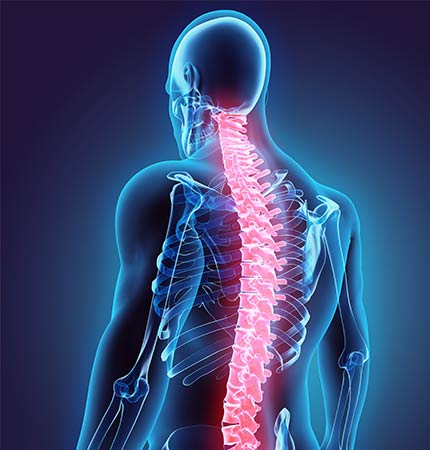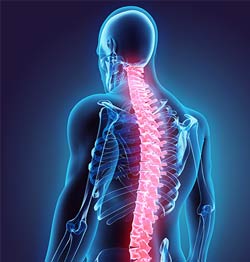Spinal Cord Stimulation Can Relief Chronic Nerve Pain from Diabetic Peripheral Neuropathy and Sciatic Nerve Pain
Spinal cord stimulation is a medical procedure used to manage chronic pain. It involves the implantation of a device that delivers electrical pulses to the spinal cord. These pulses can modify or mask the pain signals sent to the brain, providing relief from chronic pain from diabetic peripheral neuropathy and sciatic nerve pain. For more information, contact us or book an appointment online. Our clinics are located in Frisco, TX, Sunnyvale, TX, and Mesquite, TX.


Table of Contents:
What Is Spinal Cord Stimulation?
How Does Spinal Cord Stimulation Relieve Chronic Nerve Pain?
What Conditions Can Spinal Cord Stimulation Treat?
Can Patients Anticipate the Potential Pain Relief Attained from Spinal Cord Stimulation Therapy?
How Is Spinal Cord Stimulation Trial Procedure Done?
How Long Does Spinal Cord Stimulation Take to Work?
What Is the Disadvantage of Spinal Cord Stimulation?
Chronic nerve pain, also called neuropathic pain, is a medical condition caused by nerve system damage that affects 20.4% of U.S. adults. Symptoms vary from one patient to another based on the location and number of injured nerves. Shooting pain, tingling, burning, skin crawling, and itching are the most frequent symptoms experienced in neuropathic pain. Due to excruciating and ongoing pain, neuropathy severely restricts everyday activities and movement, leading to anxiety, depression, and opioid dependence. Conventional treatment for painful diabetic peripheral neuropathy and sciatic nerve pain may fail to relieve patient symptoms. However, spinal cord stimulation is an effective treatment that can alleviate chronic nerve pain while reducing the need for painkillers.
Spinal cord stimulation is an implantable medical device that generates small electrical currents around the spinal cord to lessen chronic pain perception. Remarkably, spinal cord stimulation can reduce chronic nerve pain severity by more than 50%, decreasing the need for opioid painkillers. Indeed, in diabetic peripheral neuropathy, spinal cord stimulation reduces pain and improves health, mobility, and quality of life after six months, notably, after six hours of spinal cord stimulation therapy, sciatic nerve pain significantly decreases, including plantar and severe leg pain.
Oversimplifying, spinal cord stimulation creates tiny currents that stop the injured nerves’ aberrant firing, acting somewhat like a heart peacemaker. Generally speaking, the human brain can filter out incoming information. As a result, the brain prioritizes environmental information, perceptions, and sensations required for survival and personal well-being. Under normal circumstances, pain is a human defense mechanism, a warning sign of impending bodily harm. But, after nerve damage, pain loses its protective functions and becomes.
Chronic nerve pain from diabetic peripheral neuropathy and sciatic nerve pain is caused by damaged nerve fibers that mislead the brain. Small electrodes are placed around the spinal cord injured nerve fibers during spinal cord stimulation, stopping or preventing erroneous pain signals from reaching the brain. The spinal cord prioritizes non-pain nerve fibers, interrupting pain signal transmission and alleviating chronic nerve pain.
In a nutshell, Once the electrodes are placed, and the spinal cord is stimulated, the damaged nerve fiber pain signal won’t reach the brain. In other words, the pain perception from the damaged nerve fiber will significantly decrease. To clarify, stimulation doesn’t eliminate the pain. It modifies the brain’s perception of the pain.
• Chronic Nerve Pain
• Diabetic Peripheral Neuropathy
• Back Pain, particularly back pain that persists after surgery or doesn’t respond to painkillers or traditional therapies.
• Sciatic Nerve Pain
• Postherpetic neuralgia
• Post-surgical pain
• Complex regional pain syndrome
• Pain after limb amputation.
Yes, of course. A trial procedure is carried out before the spinal cord stimulator implantation surgery. The trial procedure tests potential relief and acquaints the patient with perceptions of the current generation of the device. It is crucial to realize that the trial procedure enables receiving benefits and pain reduction equivalent to those provided by the implantation surgery.
The spinal cord stimulator trial is an outpatient procedure that takes about 45 minutes. Pain doctors use a fluoroscopy device similar to an X-ray machine to identify the affected nerve fibers. After determining the ideal placement, your physician will insert minuscule electrodes into your spine’s epidural space. Your doctor might ask for your input after placing the electrodes to adjust their position to maximize their therapeutic benefits. The electrode cord will then be attached to an external battery and placed in a belt around your waist. The trial period lasts from 3 to 16 days. After the trial period, the patient can receive a permanent stimulator implantation if the chronic nerve pain relief is equal to or greater than 50%.
On average, spinal cord stimulation starts its therapeutic effects in the first 24 hours after implantation. Filling a pain diary is pivotal to adjusting the stimulator and getting the best chronic nerve pain relief. The patient can engage in more activities than before surgery due to increased life quality and mobility and social functioning recovery.
• One of the most significant disadvantages of spinal cord stimulation is that therapeutic benefits vary from patient to patient. Thus, some patients only experience partial or less than 50% pain relief, a treatment failure.
• The stimulator doesn’t eliminate the pain or modify the pain source. It only changes the way the brain perceives it.
• Currents generated by the stimulator can be an irritation source. Thus, some patients don’t tolerate some types of stimulators, particularly those that produce paresthesia. Some stimulator devices offer different alternatives to manage chronic nerve pain and possibly regulate the tingling sensation.
• Driving and using heavy equipment is forbidden when using the spinal cord stimulation device.
To learn more about the best treatment for chronic nerve pain from diabetic peripheral neuropathy and sciatic nerve pain and discover how spinal cord stimulation can help you reduce your pain talk to our pain doctors. For more information, contact us or book an appointment online. Our clinics are located in Frisco, TX, Sunnyvale, TX, and Mesquite, TX. We serve patients from Dallas TX, Frisco TX, Mesquite TX, Sunnyvale TX, Plano TX, Garland TX, Forney TX, Cedar Hill TX, Denton TX, Balch Springs TX, and surrounding areas.





